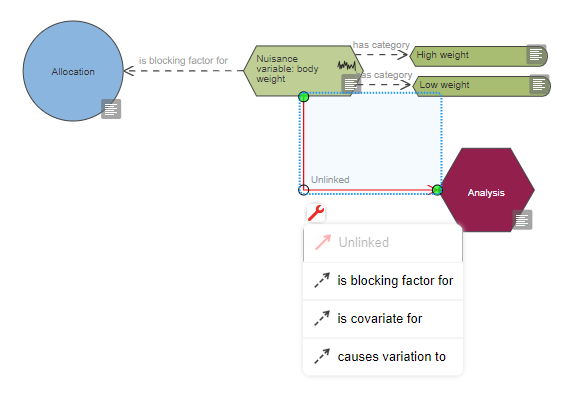This nuisance variable is a covariate but is not connected to the analysis as a covariate
In the properties of this nuisance variable, how variable is accounted for is set to ‘used as a covariate’ but it is connected to an analysis node with the link ‘causes variation to’. Using this link indicates that it is not possible to control for this nuisance variable (i.e. it is uncontrolled). If you want the system to treat this nuisance variable as a covariate in the analysis it should be connected to the analysis node with ‘is covariate for’ as this information is used to generate a recommendation regarding appropriate methods of analysis.
Including a covariate in the analysis allows the variability associated with a continuous nuisance variable to be accounted for. This may be done if experimental units differ due to the influence of a continuous numerical value that is not readily controllable. Examples of independent variables that can be used as covariates include a pre-treatment measure of the response of interest, baseline body weight or age of the animal or baseline locomotor activity.
The nuisance variable can be included in the analysis either as a blocking factor or as a covariate. There are a few reasons for choosing one over the other:
- If the factor is clearly a categorical factor, then it should be a blocking factor (i.e. pieces of equipment, days of the week).
- If the factor can be either categorical or continuous (i.e. bodyweight) then the covariate only needs 1 degree of freedom whereas the blocking factor needs b-1 degrees of freedom (where there are b blocks). This might be an important consideration in designs with small sample sizes.
- Covariates need linear relationships between the response and the covariate whereas blocking factors don't.
More information about covariates can be found in the Independent variables section of the EDA website.
How to fix the diagram
To indicate that a nuisance variable is used as a covariate in the statistical analysis, it should be connected to the analysis node, with a link ‘is_covariate_for’. Note that some variables can be considered as either continuous or categorical. For example, body weight can be considered categorical (categories: 'low weight' and 'high weight') or continuous, thus body weight could be treated as categorical and included as a blocking factor in the randomisation, and then treated as continuous and included as a covariate in the analysis. If the nuisance variable is used as a blocking factor in the randomisation and as a covariate in the analysis, it should be connected to the allocation node with a link ‘is_blocking_factor_for’ and the analysis with a link 'is_covariate_for'. In the properties of a nuisance variable, the fields 'continuous or categorical' and 'how is variable accounted for' relate to the analysis. For example, if a nuisance variable ‘body weight’ is included as a blocking factor in the allocation (i.e. animals in the 'low weight' and 'high weight' categories are randomised into treatment groups separately) and as a covariate in the analysis, then in the properties of this nuisance variable, ‘continuous or categorical’ should be set to ‘continuous or discrete’.
The analysis suggestion generated by the EDA will only take into account the nuisance variables that are connected to the analysis node. The link to the analysis node can be added by selecting the analysis node icon from the nuisance variable's next node menu and drag and drop it onto the existing analysis node on the diagram. Select the red ‘unlinked’ link created and click on the spanner icon to display the dropdown menu allowing you to select the appropriate link as shown as the image below.

In some instances a baseline measure, that is used to generate the levels of the blocking factor, can also be used to transform the data. For example, baseline bodyweight can be used as a blocking factor in the randomisation (where the blocking factor categories are low, medium and high) and animals are assigned to blocks based on their actual baseline bodyweight. The actual baseline bodyweight can also be used to transform the outcome measure - expressed as percentage of the baseline bodyweight. In this case it is not crucial to include the baseline body weight as a blocking factor or covariate in the analysis. Instead a data transformation node should be added to the diagram as shown in the image below.

Once you have modified the diagram, please critique it again.